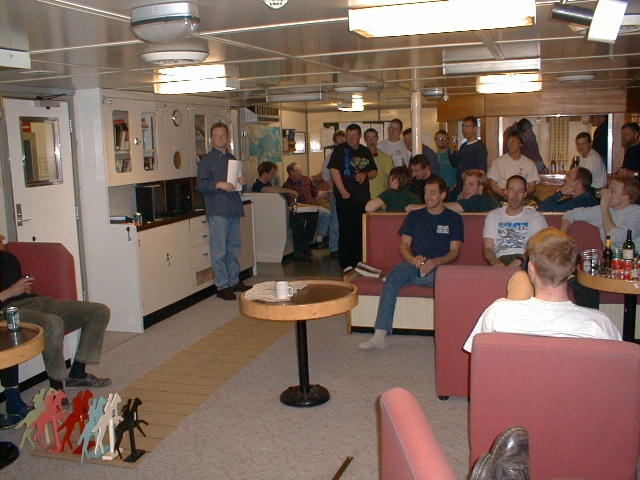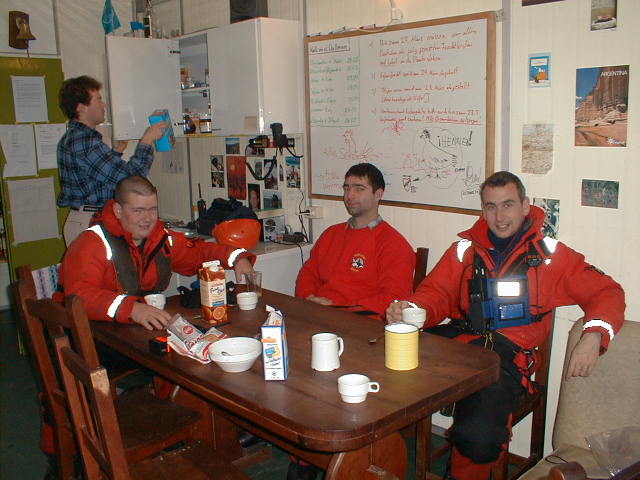| Date | Sunday 28th March 1999 |
| Time | 1200 (UTC-3) |
| Position | Latitude 51°41' South
Longitude 057°49' West Alongside FIPASS, Stanley |
| Next destination | Signy Base |
| ETA | 31st March 1999 |
| Total distance | 23137.5 Nautical Miles
(Since departing Grimsby on 17th October 1998) |
| Current weather | Bright and sunny |
| Wind | 10 kts. |
| Sea state | Calm (Stanley Harbour) |
| Air temperature | 7.2°C |
| Sea temperature | 7.8°C |
Ship's
track - Updated every six hours from the weather observations sent
to Bracknell weather centre - direct from BAS
homepage.
Summary
For those of you who have been following this page for some time, you will realise that the Bransfield has had a change of plans, for operational reasons, and instead of heading to Signy base, is now in Stanley one week early. This often happens during the course of a season, although for the Bransfield this year there has been very little change to the itinerary, and the intention is to sail from Stanley this evening for Signy and then once the closing of the base for the winter is completed the ship will sail directly for Montevideo, Uruguay, arriving as scheduled on April 10th.
Last Sunday, 21st March, saw the Bransfield sail from Palmer station at 1200 and head north up the Antarctic Peninsula to the next set of dive sites, being at Dobrowolski and The Waifs, where the divers completed a short dive. The ship then steamed overnight to Snow Island, to the South of Livingston Island, passing Deception Island (an active volcano) on the way. This was to be the last dive site for the marine biologists and the whole day was spent there. On the overnight journey from The Waifs to Snow Island an interesting phenomena was seen and the following is the extract entered into the Met. Logbook by Paul Heslop. 3rd Officer.
' 22/3/99, 0300z, RRS Bransfield, Master J.B.Marshall, Observed P.Heslop 3/O, I.Heffernan 4/O, P.Clark A/B. Position 64 05s 061 50w on passage from 'The Waifs' group to Livingston Island (between dive sites) Antarctic Peninsula. Co 012T, Speed 11kts. Conditions: A calm dark night, traces of low cumulus, with occasional well-defined banks of shallow fog, nevertheless, many stars were brightly visible. Wind light, variable, barometer 980.1 (corrected), dry bulb 0.4c Wet 0.3c Sea 0.6c
Shortly after arrival on the Bridge, for handing over the watch, between the 8-12 and the 12-4, all three observers were momentarily stunned as the entire eastern half of the sky, off the starboard side, lit up in a single, uniform flash of very bright greenish-white light, of no more than three seconds duration. During this time I could clearly see the snow and ice covered peaks of the mountains of the Christiania Islands, which were still some 12nm distant on the starboard bow, as well as what appeared to be thin ribbons of Altostratus on the horizon ahead. The light appeared to emanate from abaft the starboard beam.
The brief experience was simultaneously spectacular and somewhat
unnerving. None of us could recall ever witnessing anything remotely resembling
this before and certainly nothing involving use of conventional pyrotechnics.
There is only one research station in the vicinity, the Argentine 'Primavera'
base in Cierva Cove, 22nm to the east, and operational status of this base
could not be confirmed.
P.Heslop 3/0'
On further investigation it seems that something was also seen from Rothera base at the same time, although this was 200 miles away from our position. Having consulted Jon Shanklin at Cambridge, who is a keen astronomer as well as being a meteorologist with the BAS, the feeling is that this could have been a large meteorite entering the Earths atmosphere.
From the dive site off Snow Island the Bransfield then continued north overnight and on Tuesday morning we called into the Argentine Jubany base, located in Potter Cove on King George Island, to collect some biological samples from German scientists working there, for onward shipment to Germany. Two of the inflatable boats were sent in to the base and received a warm welcome from the base staff. Following a coffee and brief look around the base, the samples were loaded into the boats and they returned to the Bransfield. Once all was secure on board the Bransfield turned towards Stanley and the Drake Passage crossing.
It is at this point that I will give you a brief history of the Drake Passage, a section of sea that the BAS vessels frequently have to cross and always one not looked forward to, as if the sea is going to be rough, it will be on crossing this stretch of water. During Sir Francis Drake's expedition of 1577-1580 on board the Pelican (changed to Golden Hind in the eastern entrance to Estrecho Magallanes in August 1578), he was the first to demonstrate the existence of Drake Passage, being a stretch of water that separates Cape Horn from the South Shetland Islands. One of his ships, Marigold, sank during a storm in the Drake Passage on 7th October 1578). The Drake passage was first traversed in 1615 by Willem Corneliszoon Schouten, a Dutch navigator.
Wednesday night and there was a horse race held in the FIDS bar, with six races and a grand final being held. The bar was full with punters, all keen for their horse to do well. Six horses 'ran' in each race, some of which were very closely contested. The overall winner was the Great Ormand Street Hospital, as £73 was raised in their favour.
By Thursday morning we were well on our way across the Drake Passage, and at around 0400 the wind was at Gale Force 8 with the sea state being rough. The ship was rolling easily throughout the day, although this did ease once we had crossed the Burdwood Bank and so at 0700 on Friday 26th we approached Stanley Harbour with 40 knot winds. Even with the strong winds trying to blow us off of the FIPASS we were soon secure alongside and started discharging cargo and waste immediately. The wind was to be continuous throughout the discharge operations which were completed on Saturday afternoon. Twenty nine personnel disembarked at Stanley for repatriation to the UK and several flying or sailing across to South America for a well deserved holiday, traveling around Chile, Argentina and other South American countries. Fifteen personnel remain on board the Bransfield, some to return to the UK with the ship, others to conduct the final dive at Signy (to install a new tide gauge for monitoring sea level). Some of these will return to the UK from Montevideo in April.
Sunday morning was bright and clear, the wind having dropped and the
ship is being readied for sailing at 1900 today. The passage to Signy is
about two and a half days and all being well we should be ready to complete
the final job of closing the base for the winter on Wednesday morning.
Once complete the ship will head north for England via Montevideo.
Rothera Research Station, Adelaide Island (67°34'S,
068°08'W) - by Tudor Morgan.
The station is situated on a rock and raised beach promontory on the
eastern coast of Adelaide Island and the northern shore Marguerite Bay.
Mean monthly summer temperatures are in the region of -1 to +2C, while
the mean monthly winter temperatures range between -5 and -20C. Predominant
wind direction is from the north with an annual mean of 12kts.
The station wintering complement is around 20 rising up to 124 (90 on station with up to 45 in the field) in the summer, supporting the running of the station and the following scientific disciplines - glaciology, geology, geophysics (airborne and terrestrial), human physiology, meteorology, terrestrial and marine biology and upper atmospheric sciences.
Rothera Point was first occupied by a four man wintering party in 1976. Since then major phases of building and development work have taken place incorporating the construction of accommodation for 124, a garage, power generation plant, workshops for electrical, plumbing and wood works, sledge and field equipment store and workshop, 900m gravel runway, hangar facilities, fuel farm, deep water wharf, boat shed and biological laboratory. Future plans involve the construction of a new accommodation block along with refurbishment of the main building.
Rothera forms the hub of BAS air operations in support of field science and is the base for the Dash 7 and four Twin Otter aircraft doing a total of 2000 hours annually. The Dash 7 does 16 airbridge rotations a season to bring in and out urgent cargo and personnel. In support of air operations there are two major depots south of Rothera, one at Fossil Bluff (71S) and Sky Blue (75S) manned with personnel from Rothera.
RRS James Clark Ross visits early in the season to bring in personnel
and early season cargo, whilst RRS Bransfield visits late season to do
the main cargo relief and uplift of personnel before winter. HMS Endurance
also visits occasionally during the summer months.
Forthcoming Events
Signy base closure, 31st March - 1st April 1999. Head for home!!!!!
Sunday 4th April 1999, 1200 UTC on ITV. Further coverage of the ITN visit to Antarctica on board the Bransfield. This coverage has been extended from 30 minutes to 50 minutes and may possibly be rescheduled, however at the time of writing I am unable to confirm this..
GM0HCQ/MM QRV 21052/28052kHz @ 1500z 14052kHz @ 2030z & 0000z
The next update will be written on Sunday 4th April 1999 and should
be published on Monday 5th April 1999.



Last updated 30/03/1999 - webmaster@dartcom.co.uk